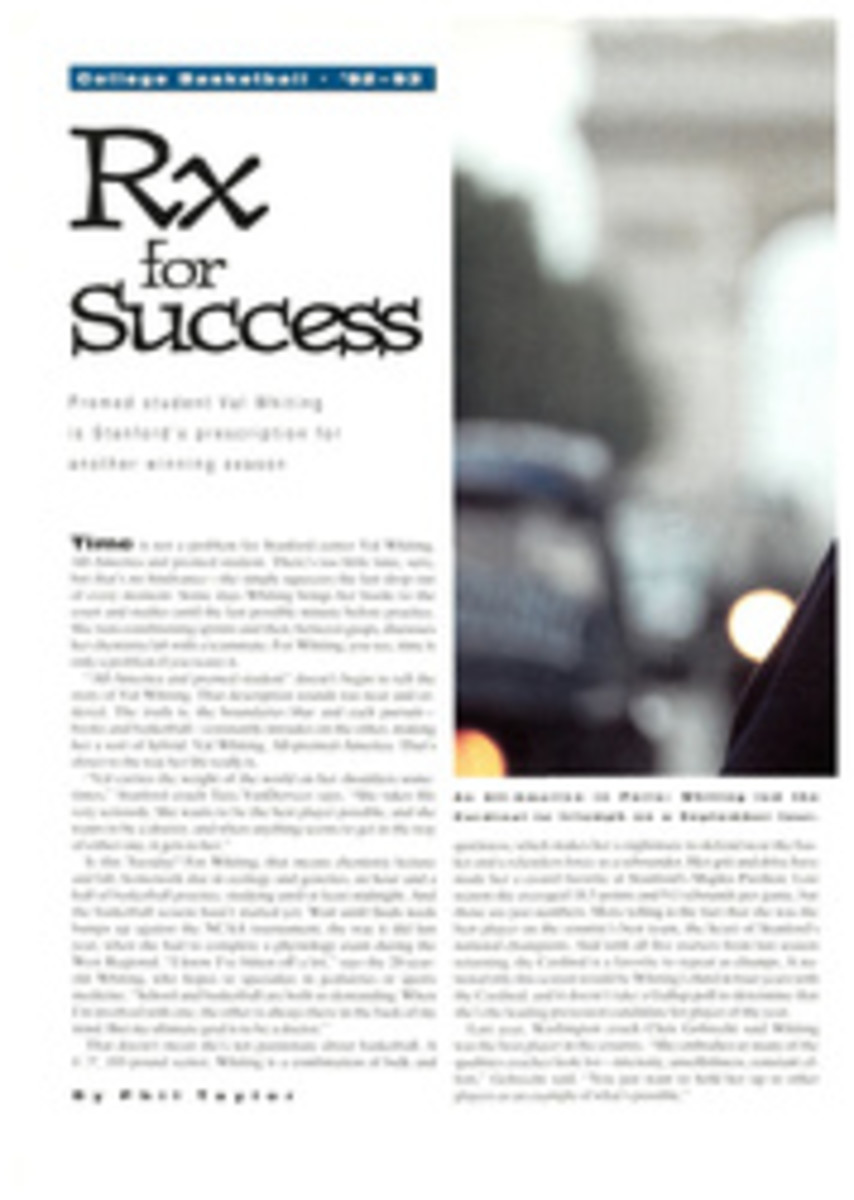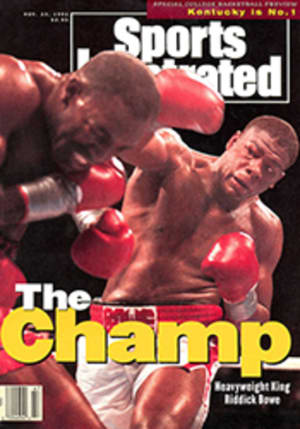
College Football
SEILER'S SIDE
For Iowa State quarterback Man Seiler, a fifth-year senior, the good news was that coach Jim Walden was giving him the first start of his career in his last home game. The bad news was that the opponent would be 29-point favorite Nebraska. "We never thought about beating them," says Seiler. "We just wanted to play them tough." The result, a 19-10 upset for Iowa State, guaranteed Seiler a celebrated spot in Cyclone history.
Until Saturday, Seiler seemed destined to be remembered for a play He had made two years ago against Oklahoma, when his pass on a fake punt set up an important touchdown in a 33-31 victory. But that was nothing compared with beating the seventh-ranked Cornhuskers, who hadn't lost to the Cyclones in 14 years. What's more, a week before this year's game, Husker athletic director Bob Devaney, who coached Nebraska to national championships in 1970 and '71, said that the 1992 team was the best in his 31 years in Lincoln.
Amazingly, Iowa State, which is now 4-6, beat Nebraska at its own game—running the ball. The Cyclones outrushed the Huskers 373 yards to 192. And while Iowa State was holding Nebraska's vaunted I-backs, Derek Brown and Calvin Jones, to 64 and 28 yards, respectively, Seiler led all runners with 144 yards on 24 carries.
As a systems information management major who plans to go to work for his father's lumber company in Joliet Ill., Seiler will probably never again do anything before 42,008 people, which is how main turned out for Saturday's game. Still, when he went to Tazzles, his favorite hangout in Ames, alter the game, nobody treated him any differently. At least now, though, he knows he'll have a special place at class reunions. Says Seiler, "That was a great way for me to go out."
A MAJORS LOSS
Tennessee's decision to oust Johnny Majors after 16 years as coach of the Volunteers further reduces a breed that has become almost extinct—the football coach as larger-than-life folk hero. Nobody has ever bled Volunteer orange quite like Majors. The last in Tennessee's long line of terrific single-wing tailbacks, he led the Vols to a 10-1 record as a senior in 1956 and finished second to Paul Hornung in the Heisman balloting. When Johnny came marching home again, in 1977, having just coached Pitt to the national championship, he was viewed as the perfect choice to lead the Vols back to the heights they had reached under General Robert Neyland in the 1930s, '40s and '50s.
The 57-year-old Majors did not fail in Knoxville. After Tennessee went only 21-23-1 in his first four years, he began winning big and often. Entering this season he was 60-20-5 since 1985, and his teams had won three SEC titles and played in six bowls in that seven-year period. Yet even Majors fell victim to the unreasonable expectations that plague bigtime college football today.
Although this was supposed to be a rebuilding year for Tennessee, the fans became so excited when the Vols got oil to a 3-0 start under offensive coordinator Phillip Fulmer, who served as interim coach while Majors recovered from heart surgery, that Majors probably should have sat out the season. Instead he returned, and after two wins the Volunteers dropped three straight games, to Arkansas, Alabama and South Carolina. The losses caused such outrage, especially among influential donors, that university president Joseph Johnson caved in and refused to grant Majors the contract extension he requested. Last Saturday, Tennessee improved to 6-3 with a 26-21 win over Memphis State, but the deed was done.
So ends a sorry episode at a school where the motto should be, "What have you done for me lately?" This is the same place that was so eager to hire Majors in 1977 that it dismissed Bill Battle, who had achieved a not-so-shabby 59-22-2 record during his seven years as coach. Now, apparently, the job will go to Fulmer, whose silence grew increasingly conspicuous as fans turned up the heat on Majors.
Majors is a throwback to the days when coaches cast long shadows over their campuses. But today football coaches have become robots who don't so much coach teams as "run programs," like so many CEOs in pin-striped suits.
Why are the Bears and Woodys and, yes, Johnnys a dying breed? The answer is complex. The parity brought on by scholarship limitations, increased scrutiny by the press and the NCAA, and pressure to succeed nationally—instead of just regionally—have combined to make it difficult for coaches to survive long enough to become cult figures. Who out there still qualifies as an icon? The list is certainly shorter than it was 20 years ago, and it's one shorter than it was last week.
FOOTNOTES
Punters are usually relegated to the coffin corner of the sports page even though games often turn on their toes. This year, however, there are several men whose legs are worth noting—and whose stories are interesting, to boot.
•Before transferring to Texas-El Paso in 1991, Ed Bunn punted for Los Angeles Valley Junior College. He put himself through school there as a repo man, reclaiming cars from owners who were behind on their payments. Bunn earned as much as $600 a night, but the job was not without its hazards: Insolvent car owners broke Bunn's ankle once, fractured his wrist four times and stabbed him on three occasions. Once, after hooking up a car to his tow truck in South Central L.A., he heard gunshots, "I gave it the gas and ran a couple of red lights and four stop signs," says Bunn, who escaped unscathed but later counted 12 bullet holes in the driver's side door of his truck. Before breaking his left leg against New Mexico last Saturday, Bunn was averaging 48.3 yards per kick.
•Kansas junior Dan Eichloff was born in Germany and didn't see an American football game until he was 12, when his family moved to Fort Lauderdale. Last season Eichloff became only the fourth player to rank among the top 12 nationally in both field goals (second) and punting (12th). This year he's averaging 41.0 yards per punt, and his 15-for-17 record in field goals includes a 61-yarder—the longest in the nation in '92—against Ball State.
•As a redshirt freshman at North Carolina. Mike Thomas is the leading punter in the ACC, with a 43.3-yard average. If Thomas doesn't make it to the pros with his foot, there's always his arm—he is the Tar Heel's backup quarterback. Then again there's his bat—he hit .301 last summer for the Bluefield Orioles, a rookie league team in the Baltimore chain.
•Texas A&M senior David Davis comes from Loop, Texas, a farming community 60 miles southwest of Lubbock. Loop High is so small—there were six students in Davis's senior class—that it plays six-man football. Davis, who's averaging 45.1 yards per kick, is only the second product of a six-man football program to play for the Aggies. The first was Jack Pardee, the Houston Oiler coach who was an All-America in 1956 before he went on to a 15-year playing career in the pros.
•Ordinarily a punt returner loves to have only the punter remaining between him and the end zone, but that's not the case with Brigham Young's opponents. The Cougars' punter is 6'7", 280-pound senior Brad Hunter, who's also one of their defensive tackles. Against New Mexico, Hunter boomed a 50-yarder and then tackled the return man at the BYU 15 to save a touchdown. Hunter the punter is averaging 47.5 yards per boot.
SQUIBS
Rice, 5-4 after its 34-31 defeat of Baylor, needs to win only one of its last two games, against Navy and Houston, for its first winning season since 1963.... Wofford retired Shawn Graves's number before his last home game, a 24-22 win over Bowie State. Graves holds nine NCAA records, including most rushing yards in a career by a quarterback (5,128).
PHOTO
TED KIRK/LINCOLN JOURNAL-STAR
A seldom seen Cyclone named Seiler blew through the Cornhuskers for 144 yards.
PHOTO
ANTHONY NESTE
The Vol faithful lost faith in Majors after Tennessee suffered three consecutive defeats.
PHOTO
PLAYERS OF THE WEEK
OFFENSE
In a 52-28 defeat of Hawaii, San Diego State's Marshall Faulk ran for 300 yards on 43 carries to become the only player besides Herschel Walker to gain more than 3,000 yards in his first two seasons.
DEFENSE
Junior Leonard Renfro, a defensive tackle at Colorado, made 15 tackles, including one sack, and returned an interception 18 yards for a touchdown to help the Buffaloes defeat Kansas 25-18.
TWO-WAY
Columbia's Des Werthman, a fullback and linebacker, rushed for two TDs, kicked two PATs, caught a pass for a two-point conversion, recovered a fumble and had 16 tackles in a 35-30 upset of Cornell.
SMALL COLLEGES
Quarterback Erin Hall, a senior at NAIA Oregon Tech, ran for two touchdowns and completed 37 of 56 passes for 540 yards and four more TDs to lead the Owls to a 55-32 win over Southern Oregon.

